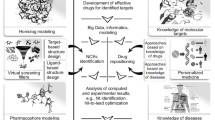Abstract
Today’s data-intensive, interdisciplinary research challenges scientists to keep up to date with key experimental techniques and tools reported in the literature. The International Union of Basic and Clinical Pharmacology Database (IUPHAR-DB) goes some way to addressing this need by providing expert-curated information sourced from primary literature and displayed in a user-friendly manner online. The database provides a channel for the IUPHAR Nomenclature Committee (NC-IUPHAR) to provide recommendations on the nomenclature of receptors and ion channels, to document their properties and the ligands that are useful for receptor characterization. Here we describe IUPHAR-DB’s main features and provide examples of techniques for navigating and exploring the information. The database is freely available online at http://www.iuphar-db.org/.
The authors wish it to be known that the first two authors should be regarded as joint First Authors. NC-IUPHAR denotes International Union of Basic and Clinical Pharmacology Committee on Receptor Nomenclature and Drug Classification. The members of NC-IUPHAR are provided in Acknowledgement.
Access this chapter
Tax calculation will be finalised at checkout
Purchases are for personal use only
Similar content being viewed by others
References
Harmar AJ, Hills RA, Rosser EM et al (2009) IUPHAR-DB: the IUPHAR database of G protein-coupled receptors and ion channels. Nucleic Acids Res 37:D680–D685
NC-IUPHAR. http://www.iuphar-db.org/nciuphar.jsp. Accessed 12 April 2012
Sharman JL, Mpamhanga CP, Spedding M et al (2011) IUPHAR-DB: new receptors and tools for easy searching and visualization of pharmacological data. Nucleic Acids Res 39:D534–D538
Hopkins AL, Groom CR (2002) The druggable genome. Nat Rev Drug Discov 1:727–730
Foord SM, Bonner TI, Neubig RR et al (2005) International union of pharmacology. XLVI. G protein-coupled receptor list. Pharmacol Rev 57:279–288
Germain P, Staels B, Dacquet C et al (2006) Overview of nomenclature of nuclear receptors. Pharmacol Rev 58:685–704
Collingridge GL, Olsen RW, Peters J et al (2009) A nomenclature for ligand-gated ion channels. Neuropharmacology 56:2–5
Yu FH, Yarov-Yarovoy V, Gutman GA et al (2005) Overview of molecular relationships in the voltage-gated ion channel superfamily. Pharmacol Rev 57:387–395
Seal RL, Gordon SM, Lush MJ et al (2011) genenames.org: the HGNC resources in 2011. Nucleic Acids Res 39:D514–D519
Blake JA, Bult CJ, Kadin JA et al (2011) The Mouse Genome Database (MGD): premier model organism resource for mammalian genomics and genetics. Nucleic Acids Res 39:D842–D848
Dwinell MR, Worthey EA, Shimoyama M et al (2009) The Rat Genome Database 2009: variation, ontologies and pathways. Nucleic Acids Res 37:D744–D749
Pruitt KD, Tatusova T, Klimke W et al (2009) NCBI reference sequences: current status, policy and new initiatives. Nucleic Acids Res 37:D32–D36
Maglott D, Ostell J, Pruitt KD et al (2011) Entrez Gene: gene-centered information at NCBI. Nucleic Acids Res 39:D52–D57
Amberger J, Bocchini CA, Scott AF et al (2009) McKusick’s Online Mendelian Inheritance in Man (OMIM). Nucleic Acids Res 37:D793–D796
UniProt_Consortium (2011) Ongoing and future developments at the Universal Protein Resource. Nucleic Acids Res 39:D214–D219
Flicek P, Amode MR, Barrell D et al (2011) Ensembl 2011. Nucleic Acids Res 39:D800–D806
Safran M, Solomon I, Shmueli O et al (2002) GeneCards 2002: towards a complete, object-oriented, human gene compendium. Bioinformatics 18:1542–1543
Berman HM, Westbrook J, Feng Z et al (2000) The Protein Data Bank. Nucleic Acids Res 28:235–242
Wishart DS, Knox C, Guo AC et al (2008) DrugBank: a knowledgebase for drugs, drug actions and drug targets. Nucleic Acids Res 36:D901–D906
Wang Y, Xiao J, Suzek TO et al (2009) PubChem: a public information system for analyzing bioactivities of small molecules. Nucleic Acids Res 37:W623–W633
Overington J (2009) ChEMBL. An interview with John Overington, team leader, chemogenomics at the European Bioinformatics Institute Outstation of the European Molecular Biology Laboratory (EMBL-EBI). Interview by Wendy A. Warr. J Comput Aided Mol Des 23:195–198
Steinbeck C, Hoppe C, Kuhn S et al (2006) Recent developments of the chemistry development kit (CDK)—an open-source java library for chemo- and bioinformatics. Curr Pharm Des 12:2111–2120
Lipinski CA, Lombardo F, Dominy BW et al (2001) Experimental and computational approaches to estimate solubility and permeability in drug discovery and development settings. Adv Drug Deliv Rev 46:3–26
PostgreSQL, version 9.0. http://www.postgresql.org. Accessed 30 March 2011
PubMed. http://www.ncbi.nlm.nih.gov/pubmed. Accessed 30 March 2011
Andrade R, Barnes NM, Baxter G et al. 5-Hydroxytryptamine receptors. IUPHAR Database. http://www.iuphar-db.org/DATABASE/FamilyMenuForward?familyId=1. Modified 28 Jan 2011. Accessed 30 March 2011
Peters JA, Lummis SCR, Barnes NM et al. 5-HT3 receptors. IUPHAR Database. http://www.iuphar-db.org/DATABASE/FamilyMenuForward?familyId=68. Modified 7 Jan 2010. Accessed 30 March 2011
Gutman GA, Aldrich R, Chandy KG et al. Calcium-activated potassium channels: KCa2.3. IUPHAR database. http://www.iuphar-db.org/DATABASE/ObjectDisplayForward?objectId=383. Modified 31 Jan 2011. Accessed 30 March 2011
Pin JP, Neubig R, Bouvier M et al (2007) International union of basic and clinical pharmacology. LXVII. Recommendations for the recognition and nomenclature of G protein-coupled receptor heteromultimers. Pharmacol Rev 59:5–13
The Open Babel Package, version 2.2.3. http://openbabel.sourceforge.net/. Accessed 30 March 2011
Acknowledgements
The authors thank all contributors and members of NC-IUPHAR and its subcommittees for their ongoing support. NC-IUPHAR members: S.P.H. Alexander, T.I. Bonner, W.A. Catterall, A. Christopoulos, A.P. Davenport, C.T. Dollery, S. Enna, A.J. Harmar, K. Kaibuchi, Y. Kanai, V. Laudet, R.R. Neubig, E.H. Ohlstein, J. Peters, J-P. Pin, U. Ruegg, P. du Souich, M. Spedding, and M.W. Wright. IUPHAR-DB has been developed with financial support from the British Pharmacological Society, ASPET, Servier, GlaxoSmithKline, Pfizer, Actelion, AstraZeneca, DiscoveRx, Lundbeck, Abbott, and Merck Millipore.
Author information
Authors and Affiliations
Consortia
Corresponding author
Editor information
Editors and Affiliations
Rights and permissions
Copyright information
© 2012 Springer Science+Business Media, LLC
About this protocol
Cite this protocol
Mpamhanga, C.P., Sharman, J.L., Harmar, A.J., NC-IUPHAR. (2012). How to Use the IUPHAR Receptor Database to Navigate Pharmacological Data. In: Davenport, A. (eds) Receptor Binding Techniques. Methods in Molecular Biology, vol 897. Humana Press, Totowa, NJ. https://doi.org/10.1007/978-1-61779-909-9_2
Download citation
DOI: https://doi.org/10.1007/978-1-61779-909-9_2
Published:
Publisher Name: Humana Press, Totowa, NJ
Print ISBN: 978-1-61779-908-2
Online ISBN: 978-1-61779-909-9
eBook Packages: Springer Protocols




